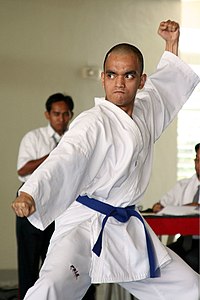
Karategi (空手着 or 空手衣), also called keikogi or dogi, is the formal Japanese name for the traditional uniform used for Karate practice and competition. [1] [2] [3] [4]

Karategi (空手着 or 空手衣), also called keikogi or dogi, is the formal Japanese name for the traditional uniform used for Karate practice and competition. [1] [2] [3] [4]

A karategi is somewhat similar to a judogi (柔道着 or 柔道衣, Judo uniform) as it shares a common origin; however, the material and cut of the uniform is generally much lighter and looser fitting. The heaviest of Karategi are only 0.5 kg (16 oz) compared to some judogi at 1 kg (35 oz). Because of the nature of Karate training which emphasizes striking, kicking and a more limited range of standing throws compared to Judo the karategi has evolved in a manner that maximizes mobility and speed without the extremely coarse and strong fabric required for grappling and throwing found in Judo. They are made from smooth cotton which may be brushed or ribbed for unrestricted movement and added comfort. Reinforced stitching is common, as to compensate for the stresses put on the gi.
Inferior karategi are often cut from a light fabric similar to that of a summer shirt. These karategi are easily ripped, and tend to adhere to the practitioner's skin, creating some discomfort after any extensive perspiration is experienced. Such materials yield a karategi no heavier than the 0.2 kg (8 oz).
Most quality karategi are cut from a light canvas style cloth because of its ability to stand up to considerable amounts of rigorous application and abuse without restricting the mobility of the karateka. Typically, such karategi weigh at least 0.3 kg (10 oz).
The weight of the material helps Karateka determine how rigid the suit will be. 0.34 kg (12 oz) or 0.40 kg (14 oz) cotton canvas is standard, although some manufacturers offer 0.45 kg (16 oz) materials. It is not unusual for a martial artist to feel better cooled when using a heavier karategi, compared to the cheaper karategi. Naturally, heavier suits will be more rigid. This rigidity increases ventilation within the suit. The heavier gi also has a more pronounced sound when a move is executed. Despite the extra weight of the heavier fabrics, most experienced practitioners prefer them due to their durability, and the ability of the thicker fabric to wick away perspiration.
The three main cuts of karate gi are Kata, European and Japanese. [5] The Japanese cut has short sleeves and trousers for less restriction. This cut also has a longer lapel that prevents it from riding up over the belt (obi). The Kata cut is very rare. It has even shorter sleeves and is chosen more for aesthetic appeal. European Cut has longer sleeves and trouser. The lapel is shorter. This cut again is chosen for aesthetic appeal. Karate uniforms come in a wide array of colours. Most Karateka still wear white. Some clubs use a system of differing colours to differentiate students from instructors.

Different styles of Karate have slightly different uniforms though all share the same basic design, differing only in the lengths of sleeves, legs and the skirt of the uwagi (jacket). Many karateka tend to wear their obi (belt) much longer than judoka and other martial artists. [6]
Karategi are sometimes worn to practice other arts, such as jujutsu, when the practitioners are young and can expect to grow out of the gi in a few years; in this case, their reduced durability in comparison to judogi is less of a factor, and buying karategi until the practitioner stops growing is more cost-effective.
The karate gi appears to have been developed from the Judo uniform. When Gichin Funakoshi demonstrated karate in Japan at the Kodokan , he still wore a traditional judo gi. [7]
"GI" is a recognised word in both the official scrabble dictionary and the Merriam Webster Second edition dictionary.

Judo is an unarmed modern Japanese martial art, Olympic sport, and the most prominent form of jacket wrestling competed internationally. Judo was created in 1882 by Kanō Jigorō as an eclectic martial art, distinguishing itself from its predecessors due to an emphasis on "randori" instead of "kata" alongside its removal of striking and weapon training elements. Judo rose to prominence for its dominance over established jujutsu schools in tournaments hosted by the Tokyo Metropolitan Police Department, resulting in its adoption as the department's primary martial art. A judo practitioner is called a "judoka", and the judo uniform is called "judogi".
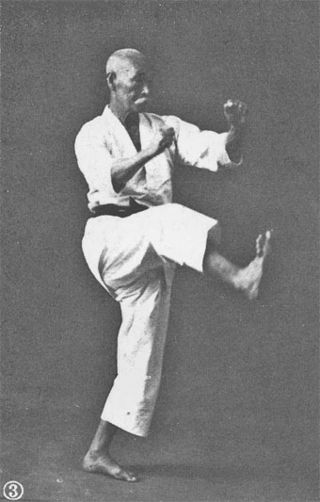
Karate (空手) is a martial art developed in the Ryukyu Kingdom. It developed from the indigenous Ryukyuan martial arts under the influence of Chinese martial arts, particularly Fujian White Crane. Karate is now predominantly a striking art using punching, kicking, knee strikes, elbow strikes, and open-hand techniques such as knife-hands, spear-hands, and palm-heel strikes. Historically, and in some modern styles, grappling, throws, joint locks, restraints, and vital-point strikes are also taught. A karate practitioner is called a karateka (空手家).
Randori (乱取り) is a term used in Japanese martial arts to describe free-style practice (sparring). The term denotes an exercise in 取り tori, applying technique to a random succession of uke attacks.
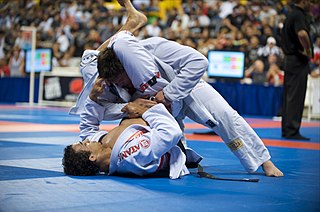
Brazilian jiu-jitsu is a self-defence martial art and combat sport based on grappling, ground fighting, and submission holds. BJJ approaches self-defense by emphasizing taking an opponent to the ground, gaining a dominant position, and using a number of techniques to force them into submission via joint locks or chokeholds.

Shotokan is a style of karate, developed from various martial arts by Gichin Funakoshi (1868–1957) and his son Gigo (Yoshitaka) Funakoshi (1906–1945). Gichin Funakoshi was born in Okinawa and is widely credited with popularizing "karate do" through a series of public demonstrations, and by promoting the development of university karate clubs, including those at Keio, Waseda, Hitotsubashi (Shodai), Takushoku, Chuo, Gakushuin, and Hosei.

Gōjū-ryū (剛柔流), Japanese for "hard-soft style", is one of the main traditional Okinawan styles of karate, featuring a combination of hard and soft techniques. Both principles, hard and soft, come from the famous martial arts book used by Okinawan masters during the 19th and 20th centuries, the Bubishi. Gō, which means hard, refers to closed hand techniques or straight linear attacks; jū, which means soft, refers to open hand techniques and circular movements. Gōjū-ryū incorporates both circular and linear movements into its curriculum, combining hard striking attacks such as kicks and close hand punches with softer open hand circular techniques for attacking, blocking, and controlling the opponent, including joint locks, grappling, takedowns, and throws.
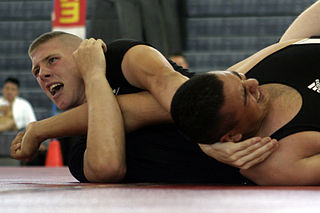
Submission wrestling, also known as submission grappling or submission fighting, is a combat sport that focus on clinch and ground fighting with the aim of obtaining a submission through the use of submission holds. The term usually refers to a form of competition and training that does not use the gi, the "combat kimono" worn in traditional martial arts. No-gi Brazilian jiu-jitsu (BJJ) is the most well known subset of submission wrestling, with the ADCC Submission Fighting World Championship considered its most prestigious tournament.
Keikogi (稽古着), also known as dōgi (道着) or keikoi (稽古衣), is a traditional uniform worn for training in Japanese martial arts and their derivatives. Emerging in the late 19th century, the keikogi was developed by judo founder Kanō Jigorō.
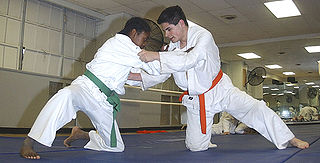
Judogi, also called keikogi or dogi, is the formal Japanese name for the traditional uniform used for Judo practice and competition.

Hélio Gracie was a Brazilian martial artist who together with his brothers Oswaldo, Gastao Jr, George and Carlos Gracie founded and developed the self-defense martial art system of Gracie Jiu-Jitsu, also known as Brazilian jiu-jitsu (BJJ).

Kata is a Japanese word meaning "form". It refers to a detailed choreographed pattern of martial arts movements made to be practised alone. It can also be reviewed within groups and in unison when training. It is practised in Japanese martial arts as a way to memorize and perfect the movements being executed. Korean martial arts with Japanese influence use the derived term hyeong and also the term pumsae.
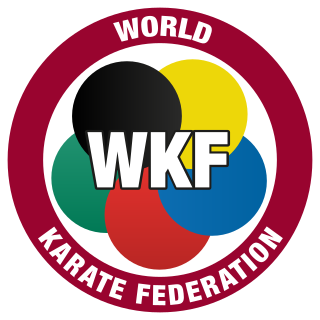
The World Karate Federation (WKF) is the largest international governing body of sport karate with 198 member countries. It is the only karate organization recognised by the International Olympic Committee and has more than hundred million members. The WKF organizes the Junior and Senior Karate World Championships, which are each held every other year. The President of the WKF is Antonio Espinós and the headquarters are located in Madrid, Spain. All the styles are officially recognised by the WKF.
Tokaido is a Japanese company that manufactures karate uniforms, belts, and related products. It is the world's oldest manufacturer of uniforms specifically for karate training, with a reputation for both high quality and high price. Tokaido is based in Tokyo, Japan, and is owned and operated by the Sugiura family.

Keinosuke Enoeda was a Japanese master of Shotokan karate. He was a former Chief Instructor of the Karate Union of Great Britain. Enoeda was ranked 8th dan in Shotokan karate, and was widely renowned as a formidable karateka. Following his death, Enoeda was posthumously awarded the rank of 9th dan.

The Brazilian jiu-jitsu gi is the training uniform adapted from the judo keikogi for use in Brazilian jiu-jitsu. A gi, meaning dress or clothes, is composed of a heavy cotton jacket, reinforced drawstring trousers, and a belt which communicates rank. Some schools require the jacket and trousers to be the same color, while more relaxed schools do not enforce matching top and bottom color. The Brazilian jiu-jitsu gi is often referred to as kimono by Brazilians. Some Jiu-Jitsu schools avoid using a gi and instead focus on no-gi jiu-jitsu; 10th Planet Jiu Jitsu is an example of this.

Jujutsu, also known as jiu-jitsu and ju-jitsu, is a family of Japanese martial arts and a system of close combat that can be used in a defensive or offensive manner to kill or subdue one or more weaponless or armed and armored opponents. Jiu-jitsu dates back to the 1530s and was coined by Hisamori Tenenouchi when he officially established the first jiu-jitsu school in Japan. This form of martial arts uses few or no weapons at all and includes strikes, throws, holds, and paralyzing attacks against the enemy. Jujutsu developed from the warrior class around the 17th century in Japan. It was designed to supplement the swordsmanship of a warrior during combat. A subset of techniques from certain styles of jujutsu were used to develop many modern martial arts and combat sports, such as judo, aikido, sambo, ARB, Brazilian jiu-jitsu, and mixed martial arts. The official date of foundation of Jiu Jitsu is 1530.
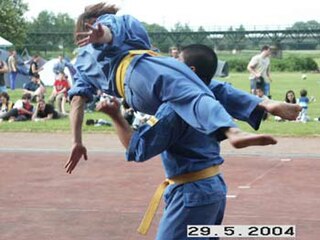
Võ phục is a Vietnamese term that refers to a martial arts uniform, mainly associated with Vietnamese martial arts, particularly Vovinam.

In judo, improvement and understanding of the art is denoted by a system of rankings split into kyū and dan grades. These are indicated with various systems of coloured belts, with the black belt indicating a practitioner who has attained a certain level of competence.

Karate at the Summer Olympics made its debut at the 2020 Games in Tokyo, Japan.
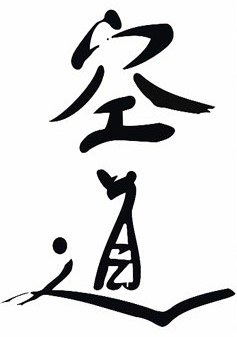
Kūdō is a Japanese hybrid martial art. It is a full-contact combat sport that aims to achieve both safety and practicality, a style of mixed martial arts practised with headgear and gloves. It features stand-up striking, with throwing and grappling techniques being also allowed in the competition, including restraint, locks and chokeholds.